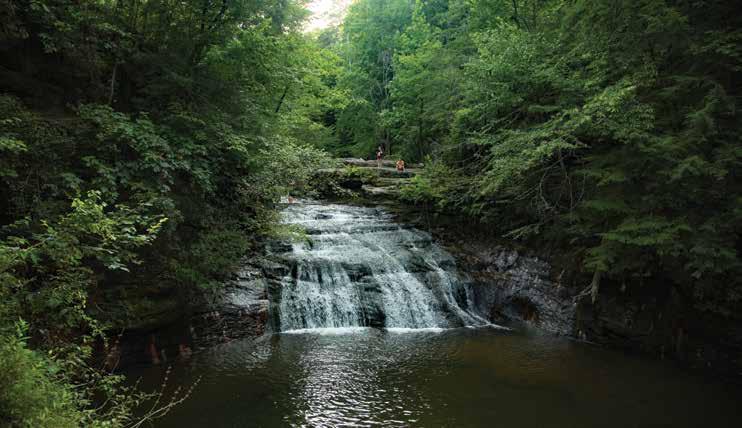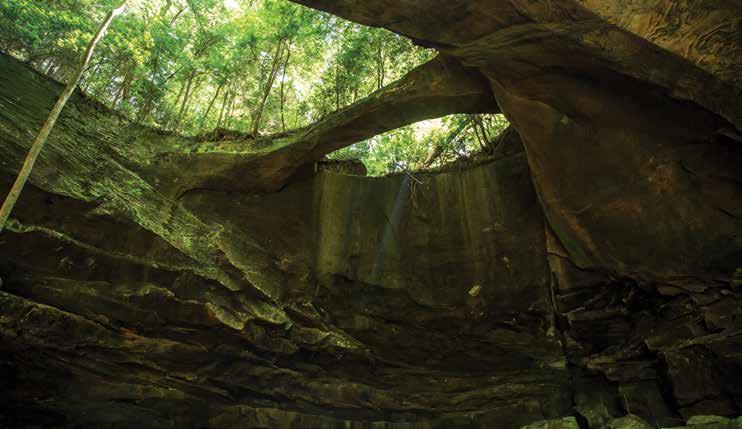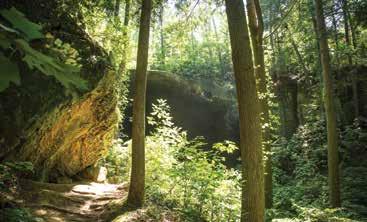
3 minute read
Into the Wilderness
WRITTEN BY JOHN PITTS | PHOTOGRAPHED BY JOE WORTHEM
Getting into the wild may be a lot easier than you think.
Advertisement
A leisurely drive from northeast Mississippi, Bankhead National Forest and its Sipsey Wilderness, located in north Alabama, can provide a wide variety of experiences for anyone looking to enjoy all the great outdoors has to offer.
This is no Disney-fied wilderness experience. Rather, this “lightly managed” woodland covers more than 180,000 acres and includes Alabama’s only National Wild and Scenic River, 61 miles of the Sipsey Fork.
First established in 1918, this national forest truly fulfills the definition established much later in the federal Wilderness Act of 1964: “(A)n area of undeveloped federal land retaining its primeval character and influence, without permanent improvements or human habitation … and managed so as to preserve its natural condition.”
But make no mistake, the area is still accessible and a visit there is a lot of fun (and yes, there are bathrooms for visitors). There’s something interesting around just about every bend in the road. And the roads there (paved or not) have a lot of bends.
“When we think of the truly wild places that remain in America’s Lower 48, we generally think of somewhere like the Frank
Church-River of No Return Wilderness in Idaho, or somewhere else well back of beyond hidden deep in the Rockies, but there are places much easier to get to, much closer to home,” said veteran Mississippi outdoor writer Kevin Tate.
“The Sipsey Wilderness, part of the Bankhead National Forest, is much more accessible, much less brutal, every bit as beautiful and not far away,” Tate said.
Out there, where cell phone service can falter, it’s possible to just stand still and listen to everything you can’t hear in the city — including the soothing sound of wild running water, especially at one of the forest’s many waterfalls.
There’s a reason, after all, folks call it “the land of a thousand waterfalls.” And, at the right time of year, it’s also home to many thousands of birds. For the past 16 or 17 years, Sipsey has been a go-to destination on the popular Alabama Birding Trail.
“Migratory birds come through in the spring on their way north from Central or South America, but there are plenty of birds who make their homes there,” said Ken Ward of the North Alabama Birdwatching Society. “It’s a particularly good area to spot all kinds of warblers.”
Especially prized are sightings of Cerulean Warblers, “dazzling jewels” that often make their warm-weather homes in the park.
But if you’re not interested in chasing either waterfalls or birds, the other options are almost endless — hiking, camping, horseback riding, hunting, boating, fishing and canoeing. Just to name a few. There’s even a designated trail for ATV-style vehicles. Camping and hiking are especially popular activities.
“There are improved campsites and places for motor homes, too, but you can really walk out into the woods there in any direction you choose and camp pretty much wherever you like. That allows backpack hikers a legitimately wild experience,” Tate said.
In the Sipsey Wilderness, first designated by Congress in 1975, there are 12 designated trails that crisscross the 25,000-acre site.



“Sipsey has lots of well-marked and maintained trails, most of which are rated ‘easy’ or ‘moderate,’” Tate said. “What the term ‘moderate’ means may be different from one hiker to the next but, generally speaking, if a person can hike anywhere, they can hike there.
“That doesn’t mean there’s not adventure and challenge — these hikes cross the rolling foothills of the lower Appalachians, so they are real hiking trails. Still, they’re trails friendly enough for almost anyone to try.”
For Becky Tsilis, a former nurse who lives in Florence, Alabama, hitting the trails in the Bankhead forest and Sipsey Wilderness is a truly “magical” experience.





“It seems completely untouched,” said Tsilis, who works with the Muscle Shoals National Heritage Area. “You don’t see much out there that’s man-made. The trails are imperfectly perfect.”
Sometimes, a wrong turn there will work out for the best, such as happening upon the Pine Torch Church, a log building constructed in 1850. Even now, descendants of those who built it are buried in an adjacent historic graveyard.
Whether making a day trip or spending a weekend roughing it, Bankhead can be the ideal spot to choose your own adventure. One rule to bear in mind: Leave no trace behind.
“You have permission to go anywhere you’re brave enough to tread,” Tate said. “You can backpack in and camp in places car campers cannot possibly reach. That’s really special. That’s what ‘wilderness’ means to me. You can define and delineate your own experience for yourself. It can be as grand as you’re bold enough to make it.”










